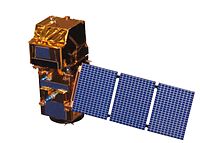
Photo from wikipedia
Abstract In this work, we investigated the trophic gradient in three reservoirs cascading in Tiete River, Southeast Brazil, based on their chlorophyll-a (chl a) concentration. The goal of this study… Click to show full abstract
Abstract In this work, we investigated the trophic gradient in three reservoirs cascading in Tiete River, Southeast Brazil, based on their chlorophyll-a (chl a) concentration. The goal of this study was to identify spatial patterns in the chl a distribution, which are associated with the filtration process caused by reservoir cascade. Hence, maps of chl a content were developed considering a short time series of MSI Sentinel-2A images (2016–2018). A chl a prediction algorithm was applied to images, whose calibration was done from data collected during a severe drought (2014), which led to intense harmful algal blooms (HABs) and after the drought (2016). The outcomes showed that 20 m spatial resolution of MSI Sentinel-2A images are suitable in estimating pigment concentration in small and middle reservoirs. In addition, the Sen2cor atmospheric correction tool exhibited good performance in removing the scattering effects. Its application in retrieving the chl a content also presented good results. Besides reservoir order in the cascade, the storage system showed to be a factor that also affects the trophic state in downstream impoundments.
Journal Title: Advances in Space Research
Year Published: 2019
Link to full text (if available)
Share on Social Media: Sign Up to like & get
recommendations!